Do you ever wish you could perform one movement that challenged your upper and lower body at the same time? The overhead squat tests your mobility, stability, muscular strength, and resilience all at once. It’s also an essential component of the barbell snatch, one of the two movements in Olympic lifting.
While it may seem intimidating at first, remember — even the strongest athletes at the Olympics or CrossFit Games once struggled to learn the overhead squat in their early days.
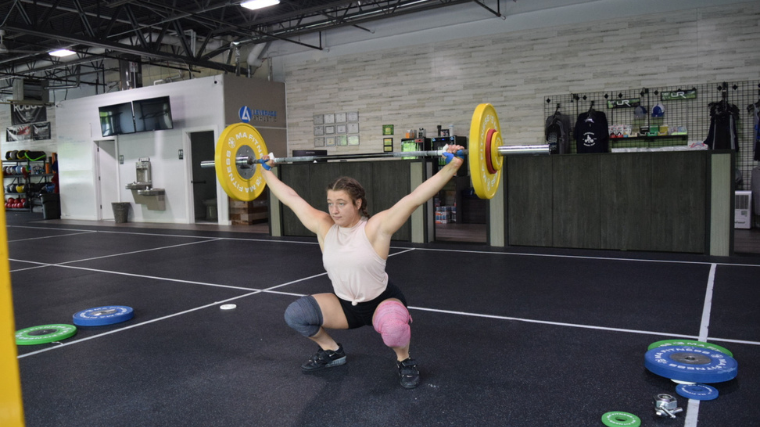
With the right knowledge in your pocket, you too can perform a picture-perfect overhead squat, no matter how far along you are on your own athletic journey. Here’s how to do it.
- How to Do the Overhead Squat
- Overhead Squat Sets and Reps
- Common Overhead Squat Mistakes
- Overhead Squat Variations
- Overhead Squat Alternatives
- Muscles Worked by the Overhead Squat
- Benefits of the Overhead Squat
- Who Should Do the Overhead Squat
- Frequently Asked Questions
How to Do the Overhead Squat
To do an overhead squat, you’ll need a barbell, a rack to hold it in, bumper plates of appropriate weight for your skill level, and a pair of collars to keep everything locked in. If you have these items on-hand, you’re ready to go.
Step 1 — Establish Your Setup
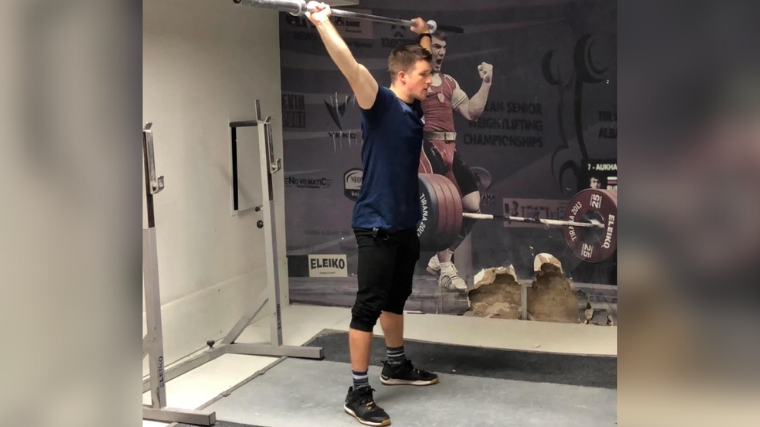
Unrack an empty barbell from a rack as if you were going to perform a standard back squat. Slide your hands out wide across the barbell, double shoulder-width apart at minimum. Place your feet in your standard squat stance. If you don’t know where that is, start by placing them under your hips, toes turned out slightly.
Coach’s Tip: Before you undertake the overhead squat, make sure you can perform a standard back squat to full depth.
Step 2 — Locate Your Overhead Position
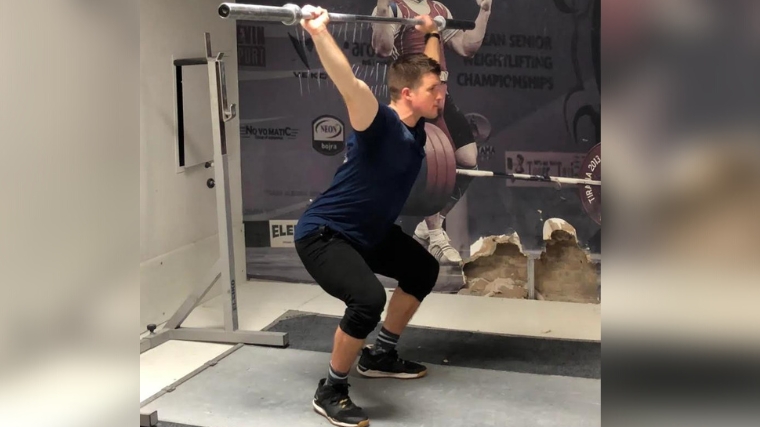
To get the barbell overhead, perform a behind-the-neck press or push press. The barbell should fixate directly above your shoulder joint, with your arms behind your ears. Push your head forward slightly and ensure that your elbows lock and stay locked the entire time.
Coach’s Tip: While your torso angle may change as you sit into the squat, your arms should be perpendicular to the floor the entire time.
Step 3 — Initiate Your Descent
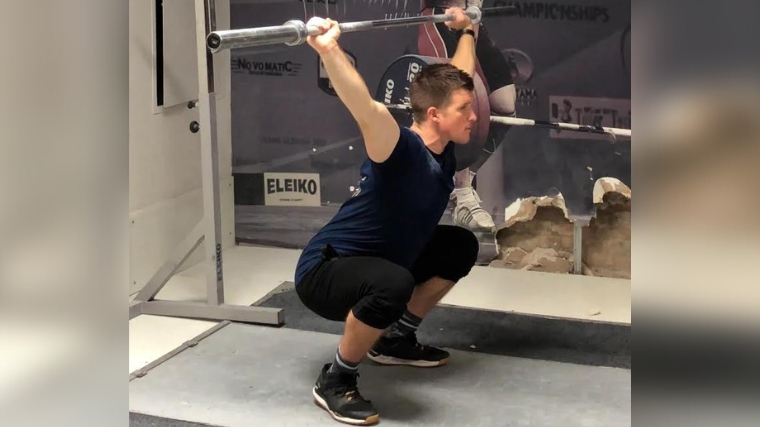
As you slowly lower into the squat, brace your core and keep your weight within the center of your foot while continuing to support the barbell overhead. Try to sit straight downward.
Coach’s Tip: As you descend, think about constantly pushing the weight up towards the ceiling with your arms.
Step 4 — Climb Out of The Hole
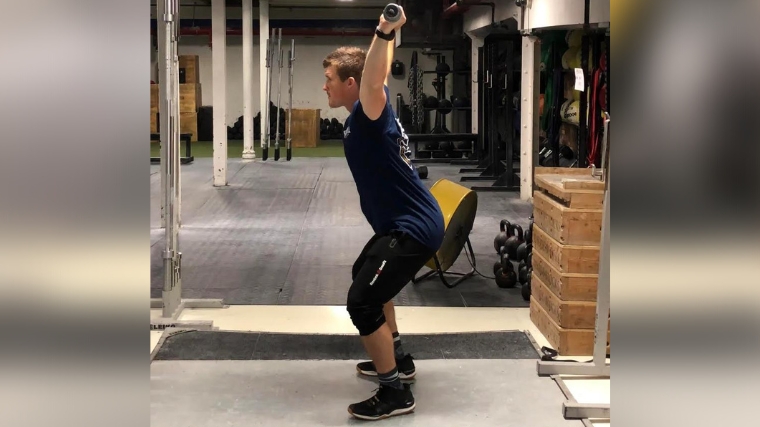
Once you’re as low as you can get, reverse the motion and drive out of the bottom of the squat with your quads and glutes. Make sure the barbell remains motionless overhead as you do this.
Coach’s Tip: Imagine that you’re pushing the earth away from you with your legs.
Overhead Squat Sets and Reps
You can train the overhead squat through various programming methods. Here are some general programming guidelines for a range of different training goals:
- For Movement Integrity: Perform 3-5 sets of 5 -10 with a PVC pipe or empty barbell. Rest 1-2 minutes between sets.
- For Strength: Perform 3-5 working sets of 1-5 reps, leaving 0-2 reps in the tank each set. Rest between 3-5 minutes between sets.
- For Endurance: Perform 2-3 working sets of 12+ reps. At the same time, utilizing a lighter load on the bar and resting 30-60 seconds between sets.
Common Overhead Squat Mistakes
An adequate level of mobility is a prerequisite to performing the overhead squat in the first place. If you don’t have the mobility to lock your elbows over your head or drop your hips lower than your knees, you won’t be able to utilize your strength. Mobility deficits are the most common issue with the overhead squat — you’ll want to identify these potential problems early.
Skipping the PVC Pipe
It doesn’t matter how strong your legs and shoulders are; if you’ve never done an overhead squat before, you will be unfamiliar with the movement pattern. Start practicing the overhead squat with a weightless PVC pipe or dowel rather than the barbell.
Practicing the movement with a light load will help you figure out where your sticking points or flexibility issues are while you learn how to compress your lower body with your arms held above you. This isn’t a skill demanded by most other types of squats, so it will feel very foreign to begin with.
Lack of Shoulder Range of Motion
Without the appropriate range of motion within your shoulders, you won’t be able to stabilize the barbell overhead. Spend time warming up the muscles surrounding your shoulder to reduce stiffness and tightness.
You may be able to perform a standard overhead press while standing, but extending your arms over your head while also flexing your lower body is a different beast entirely.
Insufficient Thoracic Extension
Adequate shoulder mobility is intrinsically linked to how flexible your torso is. You must be able to get your trunk into a solid, upright position to allow your shoulders to do their job.
You may find that your shoulders can’t support the barbell over your head because your chest collapses as you sit into the overhead squat. To remedy this, practice some thoracic spine mobilization drills or incorporate a slow movement tempo.
Stiff Ankles
To perform a squat, your knees must track over your toes to provide room for your pelvis to travel downward. Stiff or restricted ankles will generally require you to “find” your flexibility elsewhere, most commonly by sinking deeper at the hips.
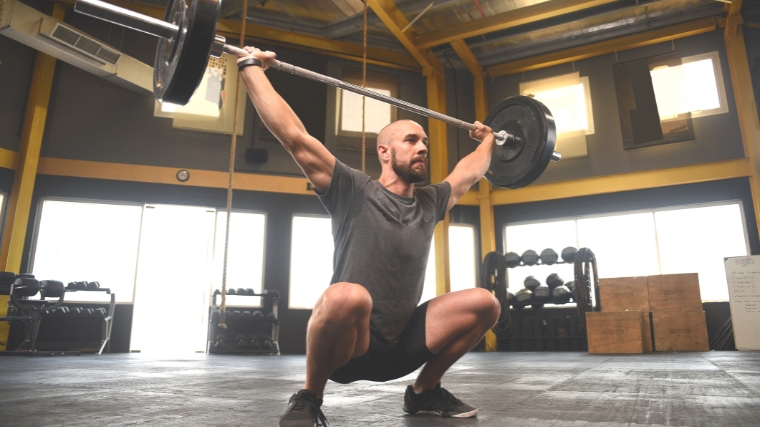
If you can’t get your knee at least in line with the end of your big toe, you may want to perform some ankle mobility exercises. Extremely flexible ankles aren’t required for the overhead squat, but they’ll make it much easier to improve your squat depth as well as how you manage the load itself.
Overhead Squat Variations
Depending on what stage you’re at when learning the overhead squat, it may be helpful to perform different variations to progress, regress, or address weaknesses — while at the same time adding some variety to keep your training fresh and fun.
Single-Arm Dumbbell Overhead Squat
This exercise will challenge your skill and mobility to perform the overhead squat with much less load; therefore, it’s another helpful progression tool you can wield. In addition, if you have any imbalances, this exercise will expose those, and consequently, you can spend time filling in those gaps with this exercise.
In addition to being much more difficult to stabilize (since you’re only working with one arm), unilateral exercises like the single-arm dumbbell overhead squat can help you expose and address any imbalances in strength or mobility.
Anderson Overhead Squat
If you’re still in the early stages of learning the overhead squat, you might want to incorporate this variation into your training. You’d usually start an overhead squat from a standing position — for new trainees, controlling a weight from the top down can be very challenging and unfamiliar.
The Anderson overhead squat flips the lift and has you begin by standing up from a squatting position. Set the barbell in a rack at around the height of your middle torso and then wrangle yourself underneath it with your arms straight. This allows you to begin the lift after using the bar itself to stabilize your torso and secure your hips.
Pause Overhead Squat
If you need to build exceptional structural stability and, especially, comfort within the bottom of an overhead squat, you can simply add a pause to the movement.
Spending a few seconds at the bottom of the overhead squat holding yourself motionless will transfer quite well when you load up for a 1-rep max or heavy snatch. The more awareness and familiarity you have with a given movement throughout its range of motion, the more confident you’ll be when it comes time to perform.
This is another excellent variation to build excellent structural stability and comfort within the bottom of an overhead squat. Spending one to five seconds within the bottom of an overhead squat can transfer over quite well to build a stronger overhead squat and snatch. The more awareness and familiarity you can have at all positions of an exercise, the more confidence you may have when you are training the movement at higher loads.
Overhead Squat Alternatives
Here are a few recommended overhead squat alternatives that may still challenge your abilities while slightly changing the stimulus to give you more variety in your training.
Single-Arm Bottom-Up Kettlebell Press
This is an excellent exercise that you can use to prep your shoulders before doing the overhead squat, or as a regression tool to build strength and stability of the musculature around the shoulder joint.
Holding a kettlebell upside down, with the bell itself on top, adds heaps of extra instability to the press. This can cue your scapulae and the surrounding musculature to engage fully, which should carry over to the overhead squat.
Dumbbell or Barbell Thruster
This exercise possesses two components of the overhead squat, the squat itself and overhead portion, into one fluid motion. Thrusters challenge your strength, mobility, body awareness, and coordination.
At the same time, it can be performed with various equipment, from a dumbbell to a barbell, with a range of loads depending on skill and strength level. You can use thrusters as a dynamic conditioning tool, or as a full-body strength movement.
Muscles Worked by the Overhead Squat
The better you can understand what muscle groups are at play during the overhead squat, the easier you’ll know what muscle groups to train to fill in any potential deficiencies. In conjunction, the more you know about how particular muscle groups behave during an overhead squat, the better a mind-muscle connection you’ll have.
Shoulders
Your shoulders act as the main anchor point during the overhead squat. Your scapulae retract and rotate upwards when you hold the barbell over your head; most of the weight of the bar itself will fall across your shoulders and upper back as a result.
Back
You undoubtedly need a strong posterior chain to perform the overhead squat. While there will be some load on your lower back, most of the challenge falls across your upper back — your latissimus dorsi, erector spinae, and many of the small tissues around your rotator cuff.
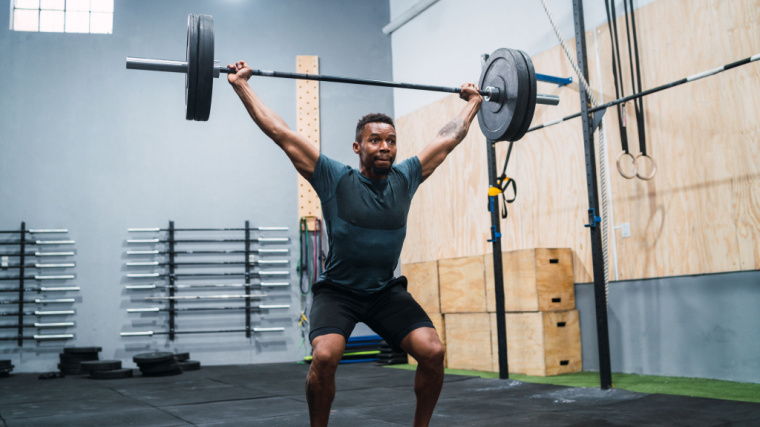
These muscles contract isometrically to provide a stable “shelf” while you squat, and also allow for adequate shoulder flexion and stability.
Abdominals
Your core — consisting of your rectus abdominals, internal and external obliques, and even your lower back — provides structural stability while you perform during the overhead squat.
Contracting your core creates an insane amount of intra-abdominal pressure, making your trunk as solid as a rock while you move. This ensures you’re in the safest and most stable position possible to balance the weight over your head and simultaneously stand up out of a deep squat.
Quadriceps
The rectus femoris, vastus lateralis, vastus medialis, and vastus intermedius make up the muscle on the front of your thigh, commonly known as your quadriceps. Your quadriceps will assist in getting you out of the bottom of the squat by extending the knee to help you return to a standing position.
Benefits of the Overhead Squat
The overhead squat is a high-skill, multi-joint exercise that will challenge you in more ways than one. This exercise will keep you on your toes by checking your strength, stability, and mobility across several areas simultaneously, all within one movement.
If you practice Olympic lifting, the overhead squat is an essential prerequisite for the sport, so you’ll have to get comfortable with it.
Builds Shoulder Stability
The overhead squat will challenge and improve the stability and strength of the musculature that makes up your shoulder joint. Shoulder health is vital for activities of daily living as well as its functionality when performing other exercises.
This makes the overhead squat a fantastic choice for isometric shoulder training, even if you don’t partake in weightlifting or CrossFit.
Improves Flexibility
The overhead squat allows you to hit two birds with one stone. When you perform the exercise, you challenge several joints at once with extreme ranges of motion.
Beyond that, though, working with a light-to-moderate load is also an effective way of engraining that flexibility and making it permanent. (1)
Improves Your Snatch
If you want a big snatch, you need to possess competence at the overhead squat first. Recovering from a heavy snatch literally requires you to stand up out of the overhead squat in the first place.
It follows, then, that if you can strengthen your technique and power during the overhead squat, some of those gains will transfer well to the snatch.
Adds Variety
The overhead squat a while to learn and even longer to master. In that way, it can be a great addition to your training arsenal if you’re looking for an exercise that challenges both your body and mind. You can use the overhead squat as a technical primer or as part of your warm-up to get your body engaged for the session ahead.
Who Should Do the Overhead Squat
Some individuals must perform the overhead squat since it’s a vital aspect of their sport, while others do it purely for the challenge and enjoyment. Wherever you fall on the spectrum, you can surely benefit from dabbling in it at least a little.
Weightlifters
In Olympic lifting, athletes are tested in both the snatch and the clean and jerk. Training the overhead squat has a direct advantage and correlation in improving the two main lifts that these athletes are tested at competitions — particularly the snatch.
CrossFitters
You’ll very regularly see overhead squats during CrossFit competitions or programmed into WODs. If you want to up your CrossFit game, you should probably be comfortable sitting in the hole of a squat with a bar over your head.

[Read More: The Best Ab Exercises & Workouts, According to a CPT]
Adding the overhead squat into your accessory training arsenal is a wise choice here.
General Population
The overhead squat is an advanced weight training exercise. It’s not necessarily appropriate for everyone that sets foot in a gym. That said, the everyday gymgoer can certainly experiment with the movement to add in some variety or test their flexibility. There’s no shame in performing exercises that are, above all, fun to do.
Wrapping Up
Now that you know what the overhead squat is, why it’s so devilishly effective, what you stand to gain from it and, most importantly, how to do it, it’s time to ask yourself the big question. Does the overhead squat belong in your workout routine?
Are you catching the competitive bug? If you want to train for an Olympic lifting meet or CrossFit class, the answer is yes. If your workouts are feeling a bit stale and repetitive, unsurprisingly, the answer is also yes.
FAQs
The overhead squat can be a real head-scratcher. Here are a couple of common questions about the exercise, addressed and unpacked.
Why is the overhead squat so challenging?
It’s a multi-joint exercise requiring high mobility, stability, and body awareness. Many people can squat with a weight in their hands, or press a weight over their heads while standing. It’s very difficult to coordinate your lower and upper body at the same time, though.
Do I have to do the overhead squat?
There’s no exercise you have to do, but if you wish to compete in a sport that requires the movement pattern of a specific lift, you’ll have to do what the sport or that style of training demands. But no, you don’t have to do the overhead squat to improve your physique or performance, but it’s certainly an option.
What’s the best way to get started doing overhead squats?
Finding a good teacher, either in person or online, can be very valuable in the learning process to give you feedback. Practice with a PVC pipe first and work on your mobility if you can’t yet work with the barbell.
References
- Alizadeh, S., Daneshjoo, A., Zahiri, A. et al. Resistance Training Induces Improvements in Range of Motion: A Systematic Review and Meta-Analysis. Sports Med (2023).
Featured Image: William Johnson / @barbellstories